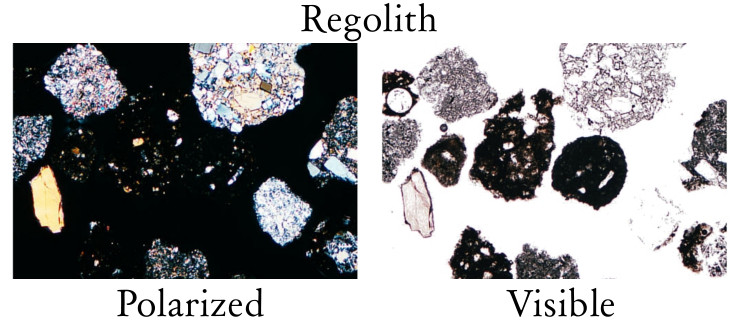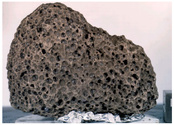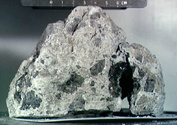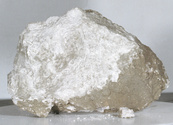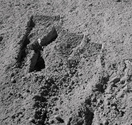
The Apollo lunar exploration project was perhaps the single most ambitious engineering project of the 20th century. Although science was not the reason Apollo went to the moon, its most lasting legacy may be that 35 years after the last Apollo left the surface of the Moon, scientific papers are still being published based on the samples returned by the six lunar missions.
Lunar samples are the only extraterrestrial material brought back from a specific geographical location by spacecraft (as of 2009). They have been of great value in advancing our understanding of the Moon and the history of our solar system. An immense amount of scientific work has been done on them by scientists around the world and the quantity of information they have provided is staggering.
The samples that we will examine were brought back by the astronauts of the Apollo program. Lunar samples were also returned by three Soviet robot probes that landed after Apollo. The Apollo program first landed on the Moon in July of 1969 with the landing of Apollo 11; it ended in December of 1972, when Apollo 17 returned to the Earth. In this amazingly short time of two-and-a-half years, six different places on the Moon were explored, thousands of pictures were taken, and 382 kg of rocks and soil were collected. A summary of the missions is printed below.
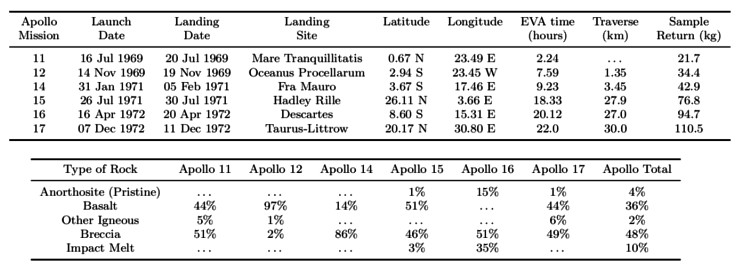
Mare Basalts - The first lunar samples brought back by Apollo 11 from Mare Tranquillitatis were black volcanic basalts. The basalts came from different depths, from the surface down to 100's of meters deep, spilling out onto the mare surface as very fluid lava, filling up the large impact basins of the Moon. They have ages ranging from 3.2 to 3.9 billion years. They are very similar to terrestrial basalts except for some minor chemical differences. Lunar basalts have fewer iron-like elements and fewer elements with low melting temperatures (volatiles).
Impact Breccias - Breccias are composite rocks made by the solidification of a mix of various irregularly sized and shaped pieces of various rocks. They were formed by impact events, which first shattered and then compacted pieces of rock from different places, melting them together. Lunar breccias usually consist of grains of various sizes. Typical grains are centimeter and millimeter chunks welded together in a finer-grained matrix. Lunar breccias can have a wide variety of ages depending on the rock incorporated within them. The fact that most of the Apollo samples were breccias demonstrates how pervasive impacts were throughout lunar history.
Pristine Highland Rocks - As their name implies, pristine highland rocks are rocks collected mainly in the lunar highlands that have not been substantially altered by reheating since they were first formed. These rocks may represent material from the original lunar crust that formed between 4.6 and 4.3 billion years ago. The chemical composition of these rocks implies the outer layers of the Moon experienced extensive melting in its early history. These types of rocks are very rare in the Apollo collection. The most famous of these rocks is the "Genesis Rock" collected by Apollo 15. In this class, I will sometimes refer to there type of rocks as Anorthosite.
Regolith - The lunar regolith is a loose "soil" that covers the Moon from a depth of a few meters on the mare, to a few tens of meters on the highlands. It was created by the continuous, slow, plowing action of meteoritic bombardment. The regolith shows a wide range of particle sizes and compositions. The main composition reflects the local underlying rock. On the mare surfaces, the regolith is basalt rich, while on the highland surfaces, there is a greater abundance of pristine highland rocks fragments. In most samples one can find tiny glass spherules. Meteoritic material is also present, but is very rare.
A thin section is a hair-thin slice of rock, mounted on a microscope slide. The rock is ground down to about 30 micrometers thick (1000 micrometer = 1 mm). What you end up with is a translucent sliver of stone, thinner than paper. To the naked eye, a thin section is nearly transparent, and that's true under the microscope too. Even dark minerals like garnet or olivine are clear.
When these thin--sections are view under a polarizing microscope, the different minerals take on colors that sometimes are quite vivid. Basically, those colors tell the observer a lot about a mineral's identity and composition. The images that we will look at in this lab are thin--sections of lunar rocks taken through a microscope, both in the visible light and with polarizing filters.
Mare Basalts - The basalts often show long, thin crystals, sometimes irregularly shaped. The sizes of the crystals are a function of the cooling time. Fast--cooling lava produces small crystals, while slow--cooling lava leads to larger crystals. Small sized crystals tend to be much more common, suggesting that most of the basalt cooled rather quickly. There is often a matrix of different--sized small crystals. The crystals often show fracturing. The grains show a wide range of colors under the polarizing filters (like a stained glass window). The various colors correspond to a variety of minerals. The most common minerals are pyroxene (yellow), feldspar (grayish, often with bands), olivine (bright colors), and sometimes ilmenite (opaque).
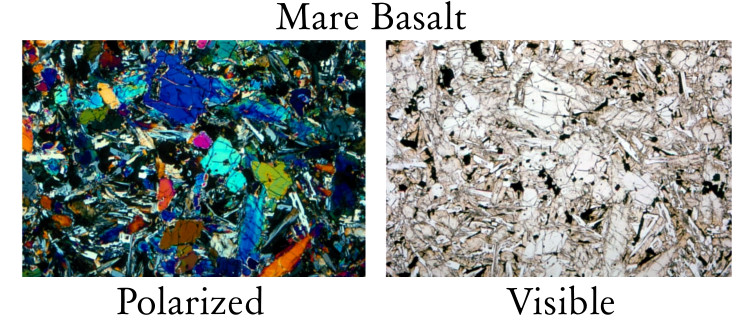
Impact Breccias - Lunar breccia show a large range of particle sizes, with small grains being the most abundant. Unlike basalts, the small grains are usually not distinct crystals. The matrix (the material between the larger grains) is fine--grained, and sometimes glassy or black. Since impact breccia is made up of whatever rock was on the ground at the time of the impact, you can often see little pieces of basalt or pristine highland rocks in the breccia. Often you see smaller, distinct breccias inside larger breccias. The colors you see under the polarizing filters vary depending on what type of rock the breccia is composed of.
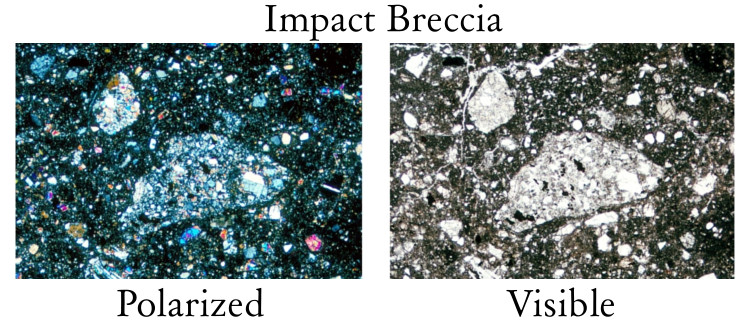
Pristine Highland Rocks - The grains of pristine highland rocks rocks are usually large (up to 1 cm), coarse, angular, and fractured. The large grain sizes imply slow cooling and the fractures are due to shocks caused by impacts. The grains are mostly composed of low density materials such as feldspar. The colors of grains are usually white to grey-blue under the polarizing filters. There are far few colors than you see in basalts. This is a reflection of the fact that these rocks are composed mostly of one type of mineral.
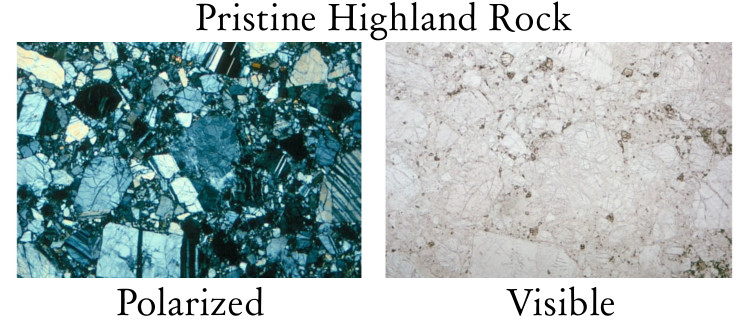
Regolith - The regolith samples are made up of separate pieces of millimeter-sized materials. The particles are distinct, there is no matrix between the particles like there is in a breccia. Sometimes glass spherules or other irregularly-shaped pieces of glass are visible among the particles. Look for basalt, breccia, and even pristine highland fragments.
